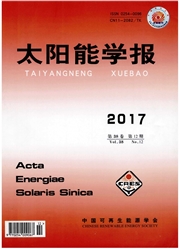

 中文摘要:
中文摘要:
To simulate floating offshore wind turbine(FOWT)in coupled wind-wave domain via CFD method,the NREL 5MW wind turbine supported by the OC3-Hywind Spar platform is modeled in the STAR-CCM+ software.Based on the Reynolds-averaged Navier-Stokes(RANS)equations and re-normalisation group(RNG)k-εturbulence model,the rotor aerodynamic simulation for wind turbine is conducted.Numerical results agree well with the NREL data.Taking advantage with the volume of fluid(VOF)method and dynamic fluid body interaction(DFBI)technology,the dynamic responses of the floating system with mooring lines are simulated under the coupled wind-wave sea condition.The free-decay tests for rigid-body degrees of freedom(DOFs)in still water and hydrodynamic tests in a regular wave are performed to validate the numerical model by comparing its result with the results simulated by FAST.Finally,the simulations of the overall FOWT system in the coupled wind-wave flow field are carried out.The relationship between the power output and dynamic motion responses of the platform is investigated.The numerical results show that the dynamic response of wind turbine performance and platform motions all vary in the same frequency as the inlet wave.During platform motion,the power output of wind turbine is more sensitive than the thrust force.This study may provide some reference for further research in the coupled aero-hydro simulation of FOWT.
 英文摘要:
英文摘要:
To simulate floating offshore wind turbine (FOWT) in coupled wind-wave domain via CFD method, the NREL 5 MW wind turbine supported by the OC3-Hywind Spar platform is rrlodeled in the STAR-CCM+soft-ware. Based on the Reynolds-averaged Navier-Stokes (RANS) equations and re-normalisation group (RNG) k-ε turbulence model, the rotor aerodynamic simulation for wind turbine is conducted. Numerical results agree well with the NREL data. Taking advantage with the volume of fluid (VOF) method and dynamic fluid body interaction (DFBI) technology, the dynamic responses of the floating system with mooring lines are simulated under the cou- pled wind-wave sea condition. The free-decay tests for rigid-body degrees of freedom (DOFs) in still water and hy- drodynamic tests in a regular wave are performed to validate the numerical model by comparing its result with the results simulated by FAST. Finally, the simulations of the overall FOWT system in the coupled wind-wave flow field are carried out. The relationship between the power output and dynamic motion responses of the platform is investigated. The numerical results show that the dynamic response of wind turbine performance and platform motions all vary in the same frequency as the inlet wave. During platform motion, the power output of wind turbine is more sensitive than the thrust force. This study may provide some reference for further research in the coupled aero-hydro simulation of FOWT.
 同期刊论文项目
同期刊论文项目
 同项目期刊论文
同项目期刊论文
 期刊信息
期刊信息
